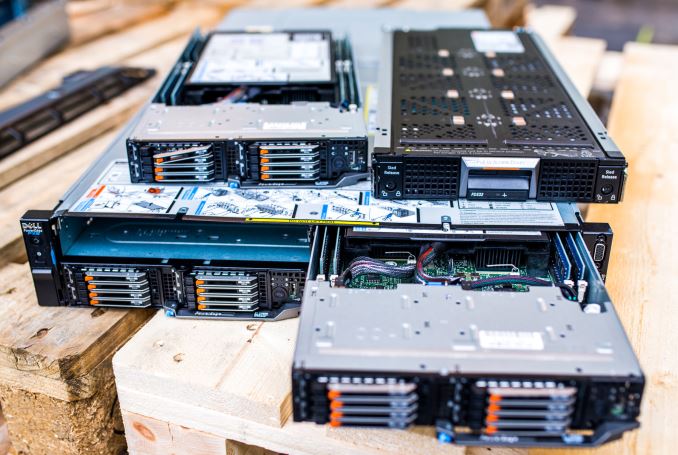The Evolution of HDDs in the Near Future: Speaking with Seagate CTO, Mark Re
by Anton Shilov on July 6, 2016 2:00 PM ESTNew 10K and 15K RPM HDDs Incoming
Hard drives with 10K and 15K spindle speeds are used to store mission-critical applications and data that also require high performance. Such drives typically use a SAS interface with its advantages over SATA/AHCI. Plenty of legacy systems and setups still rely on these fast hard drives, and as a result these systems are not going to be decommissioned in the near future. Nonetheless, the total available market for ultra-fast HDDs with 10K and 15K RPM spindle speeds has shrunk in the recent years due of SSDs. This does not mean that speedy HDDs no longer evolve - Seagate informed us that it is preparing another generation of 10K and 15K RPM HDDs.
Seagate’s new generation of 10K hard drives will not only feature 10K RPM spindle speed as per the name, but also TDMR technology — two readers per head. Those readers will read one track to improve signal to noise ratio and enable higher capacities. Keeping in mind that we are talking about critical storage applications, HDDs with two readers per arm will keep using PMR or SMR recording technology, but eventually the tech could be used for HAMR-based drives.
When it comes to 15K HDDs, Seagate seems to be somewhat more humble or secretive. The company did confirm that it is working on at least one more generation of 15K hard drives. The high-performance SAS deployments are already there and someone needs to serve them, which is where the next-generation 15K HDDs may come in handy. Moreover, SNIA has a long roadmap for SAS towards 24 Gb/s transfer speeds and the year 2020 ahead of it, which is why it is important for Seagate to offer both HDD and SSD solutions for this market. The next generation of 15K HDDs could be the last generation of such hard drives, which is why it will have to offer a balance of features and technologies that Seagate does not want to discuss at this time. Perhaps, not because of competitive reasons, but because it is working with its customers to enable features that they need.
Nonetheless, as new data center platforms arrive, the need for 15K HDDs will inevitably decrease and Seagate understands that. For example, Intel’s latest SSDs for mission-critical applications rely on PCIe bus and NVMe protocol. As a major provider of ultra-high-end Nytro storage accelerators, Seagate will naturally follow market’s trends, but this is a topic to be covered by an SSD-related conversation.











91 Comments
View All Comments
Notmyusualid - Wednesday, July 6, 2016 - link
Just lost my Seagate 4TB 2.5" internal disk last week.Luckily my most precious things were backed-up elsewhere, but dam, 2.4TB lost.
jwcalla - Thursday, July 7, 2016 - link
I'm honestly fed up with the poor reliability of HDDs. Of the three ones I still had in service, two are dead, and I'll never buy those two brands again.Michael Bay - Thursday, July 7, 2016 - link
Out of not so idle interest, what were they?kamm2 - Thursday, July 7, 2016 - link
This was in the back of my mind the whole time I read this article. What good is any of this if the damn drives keep dying? Maybe things are different on the enterprise side but I've given up on Seagate drives.jbrizz - Wednesday, July 6, 2016 - link
Can we just have 5.25 inch hard drives again? I don't care so much about density at home, but I need to hoard more files!rstuart - Wednesday, July 6, 2016 - link
I like most have move to use SSD exclusively for the, hmm, "boot drive", But I do use HDD's for media storage where only the biggest highest density drive works. SSD's are currently about an order of magnitude more expensive per byte in this area. At a wild guess SSD's might reach price parity in a decade, but for now the HDD's are the only sane choice.I'm currently struggling to fit in 6TB. My guess is 10Tb would be enough for the foreseeable future, and 20Tb would cover everything I am every likely to need. So I rather pleased to see Mr Re say they will hit 20Tb in a few years.
patrickjp93 - Wednesday, July 6, 2016 - link
Samsung is hitting 15TB this year, so Seagate is done in enterprise. The performance/watt/$ is just vastly superior for SSDs. Once storage density is also in the wheelhouse of SSDs, the scales will tip and never go back.gospadin - Thursday, July 7, 2016 - link
absolute density (TB/m3) is already in SSD's advantageThe biggest 2.5" HDD you can buy today is 2TB. In that form factor, Samsung is currently selling 4TB SSD, with 8TB/16TB drives announced.
Lolimaster - Friday, July 8, 2016 - link
Do like me:4x6TB WD blues, so should be covers for some time.
anactoraaron - Thursday, July 7, 2016 - link
This paragraph was enlightening -HDDs that use shingled recording write new tracks that overlap part of the previously written magnetic tracks. The overlapping tracks may slow down writing because the architecture requires HDDs to write the new data and then rewrite nearby tracks as well.
Which explains why my 5tb seagate with this tech can't seem to get past 40MB/s when writing to the drive.
Then read this - Ultimately, environments that involve a decent amount of writing might not be impressed with SMR performance, but the key figure here is density.
Is anyone getting a high capacity drive going to be impressed with 2-40 MB/s?
No. No they will not.